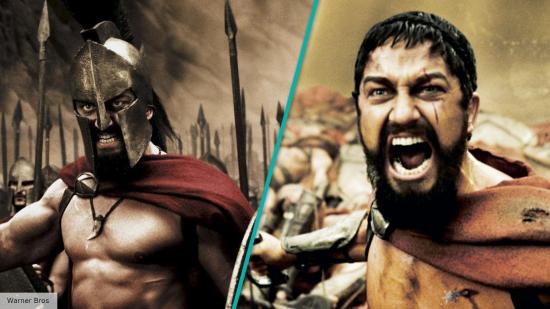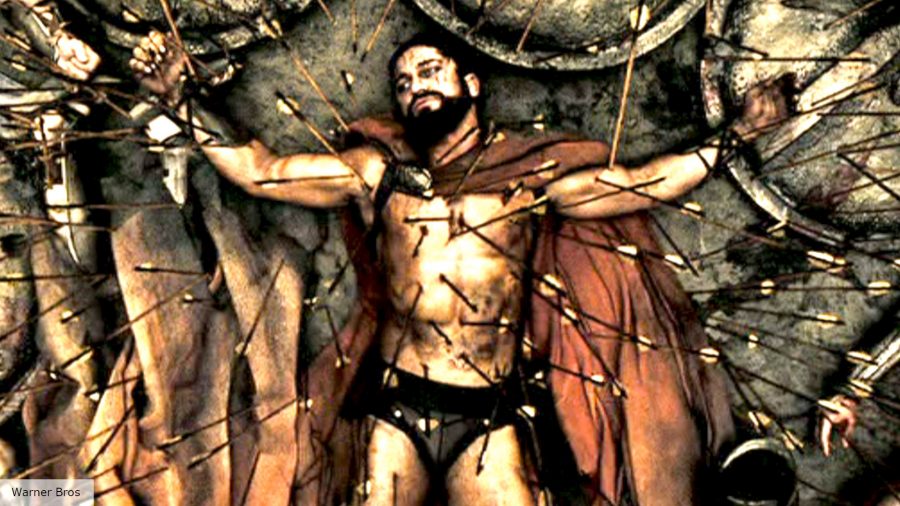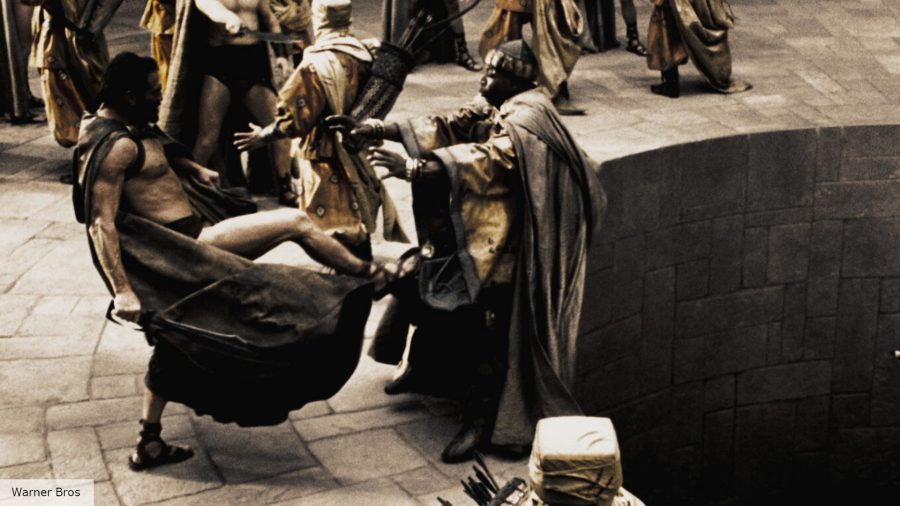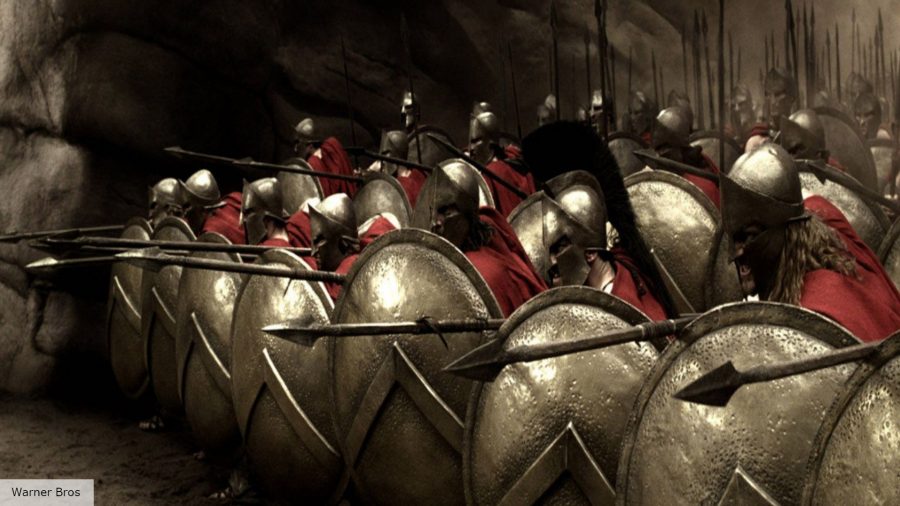300, starring Gerard Butler as King Leonidas, is one of the best action movies but how historically accurate is it? Here we go over the real story of Sparta

In 2007 Zack Snyder helmed the dark and gritty action movie 300, which saw ancient Greece thrown into a bloody war against Persia. In the thriller movie, Gerard Butler takes charge as the Spartan King Leonidas, who defies the words of The Oracle and leads 300 warriors into battle against one of the largest armies in the world.
But, with fantastical elements sprinkled throughout the flick, you may be wondering if this ‘historical film’ is actually based on a true story? Spoiler alert– yes, yes it is.
The film 300 begins with a Persian messenger approaching King Leonidas asking for a tribute for the God-King of Persia, Xerxes (Rodrigo Santoro). However, after his Queen is insulted, and being familiar with the country’s tendency to dominate its neighbours, Leonidas proceeds to kick the diplomat into a giant hole and readies himself for conflict.
But fate is not on his side as the corrupt Ephors deliver a prophecy forbidding war, leading him to break tradition and face Persia without his full army. To save his home, Leonidas enlists 300 of Sparta’s best warriors to fight for freedom and Greece’s future.
Although there may be wild inaccuracies, strange goat people, and an army full of monsters in 300, the battle upon which Snyder’s film is centred around is surprisingly very real. The 2000s movie is based on Frank Miller’s graphic novel of the same name, which in turn, is based on The Battle of Thermopylae.
The Battle of Thermopylae took place in 480 B.C and lasted for three days. The conflict was extensively documented by the ancient Greek historian Herodotus and the Sicilian historian Diodorus Siculus.
King Xerxes, who was indeed real, amassed a giant army with the hopes of conquering the remaining independent nations of Greece after gaining control of the majority of the Greek Cities. Sparta and Athens joined forces in order to combat Persia, with King Leonidas of Sparta taking 300 of his warriors and slaves to lead the battle.
Thermopylae (which translates to ‘the Hot Gates’) refers to the place in the Malian Gulf on the mouth of the Spercheios River that in the past held a narrow and very strategic strait.
This would be where the Spartans stationed themselves, and was how they could battle and win against the overwhelming number of enemies, who couldn’t encircle them during combat. Leonidas and his men experienced many small victories and devastated foes through using this strait– defying all the odds.
But on the second night of the battle, The Greeks’ luck ran out as the Persians discovered a hidden path around their position.
Leading 100 troops, Leonidas sought to defend the path; however, as the overwhelming number of enemies encircled his men, the King of Sparta ordered most of his allies to fall back while he sacrificed himself – ultimately providing a rearguard to protect the Greek retreat.

Make no mistake, 300 isn’t a replica of the events from this real-life war. Firstly, Xerxes wasn’t an 11-foot giant with a deep electronic voice.
There were no monsters among their enemy’s ranks. In reality, the 300 Spartans were joined by a large number of Greek soldiers, resulting in the King having around 5,000 troops in total (if not more).
It should also be noted that during a video journal released in 2007, it was revealed that 300’s choreographer, Damon Caro crafted fight scenes using Filipino martial arts as a base for all of the action sequences.
We have no idea how the Spartans actually fought as there are few historical records bar a few tactics and formations detailing the Spartans’ martial arts around today.
Ephialtes, the real-life figure often debated as being the reason why the Persians discovered the secret path past the Spartan’s position, was also changed from a regular Malian Greek to a Spartan hunchback outcast in the film.
This was obviously a better narrative plot point and added an element of spicy betrayal into the movie. But in reality, a deformed Spartan betrayer wasn’t the cause of Leonidas’ downfall.

So yeah, the story of 300 is far from historically accurate. But saying that, Snyder’s adaptation of Miller’s novel does manage to capture some more truths besides the events of the Battle of Thermopylae – such as the aspects of Spartan life.
The disturbing obsession with eugenics that the Spartans held back in the day is on full display during the film, as in the movie’s opening shots, we are shown baby skulls and children being examined at a scary altar.
Infants were indeed examined in Sparta, and those deemed unfit for the Spartan lifestyle were tragically murdered. Similarly, the coming-of-age ritual seen at the beginning of 300 is also somewhat true.
Just as 300 showcases when detailing Leonidas’ childhood, young Spartan boys did have to leave their families for a training regime known as the ‘Agoge’. However, 300 again slightly deviates from full fact here.
In the film, we see Leonidas kill a wolf, but in reality, it was a little more brutal, as Spartans would suffer physical and mental punishment if their mentors caught them stealing food to survive.
Although the film does somewhat idealise the Spartan warrior myth, it also doesn’t shy away from exploring certain aspects of the historical period, no matter how disturbing, so we have to give it some points for its historical efforts, right? (even if it does make you question humanity.)

The real-life King Leonidas, just like in the movie, also went to consult with the Oracle at Delphi before proceeding to war.
And just like in the film, the oracle gave the King bad news, saying that a king would lose his life or Greece would fall. So again, Snyder and Miller managed to respect some historical accuracy in the wildly entertaining story that we saw on the big screen.
But, let’s make one thing clear: 300 is not a history lesson, and it doesn’t try to be. Snyder fully leans into Miller’s graphic novel, showing mysticism and fantasy throughout his movie. But, magic and monsters aside, 300 is based on heavily documented historical events and does evoke enough truth to make you want to probe deeper into the facts behind its script.
News
‘Reacher’ star gets political again, decries an ‘entire platform by those who mostly claim to be Christians’
Last month, actor Alan Ritchson slammed Christian Trump voters for supporting a ‘con man’ Fox News contributor Joe Concha joined ‘Fox & Friends First’ to discuss actress…
Reacher Star Alan Ritchson Rips Hateful Poltics On Heels Of Anti-Trump Rant — Says Was ‘Met With Violence’ For Speaking Out
Reacher actor Alan Ritchson tore into what he sees as hateful politics from people claiming to be Christians and said he is “met with violence” instead of generosity when he…
5 Reacher Characters Ranked By Their Chances Of Appearing In Season 3
Characters do not usually reappear in Lee Child’s Jack Reacher books, but some characters might still return in the 3rd season of Amazon’s Reacher. Custom Image by…
Reacher Season 3 Casts Chicago Med’s Brian Tee as Big Bad Quinn — Here’s Everything Else We Know
The proverbial body is still warm on Reacher Season 2, and already we have fresh intel on what the Prime Video hit’s third season will bring us. Reacher Season…
Alan Ritchson – Fast & Furious Star Threatened With Violence By Trump Fans
Alan Ritchson, who is basically known for playing Jack Reacher in the Amazon series Reacher, has expressed strong criticism toward individuals who claim to be Christians but, in his…
Reacher season 3 premiere date: A May 2024 update
With us know set to dive head-first into the month of May, what more can be noted about a Reacher season 3 premiere date? The first thing that we…
End of content
No more pages to load











